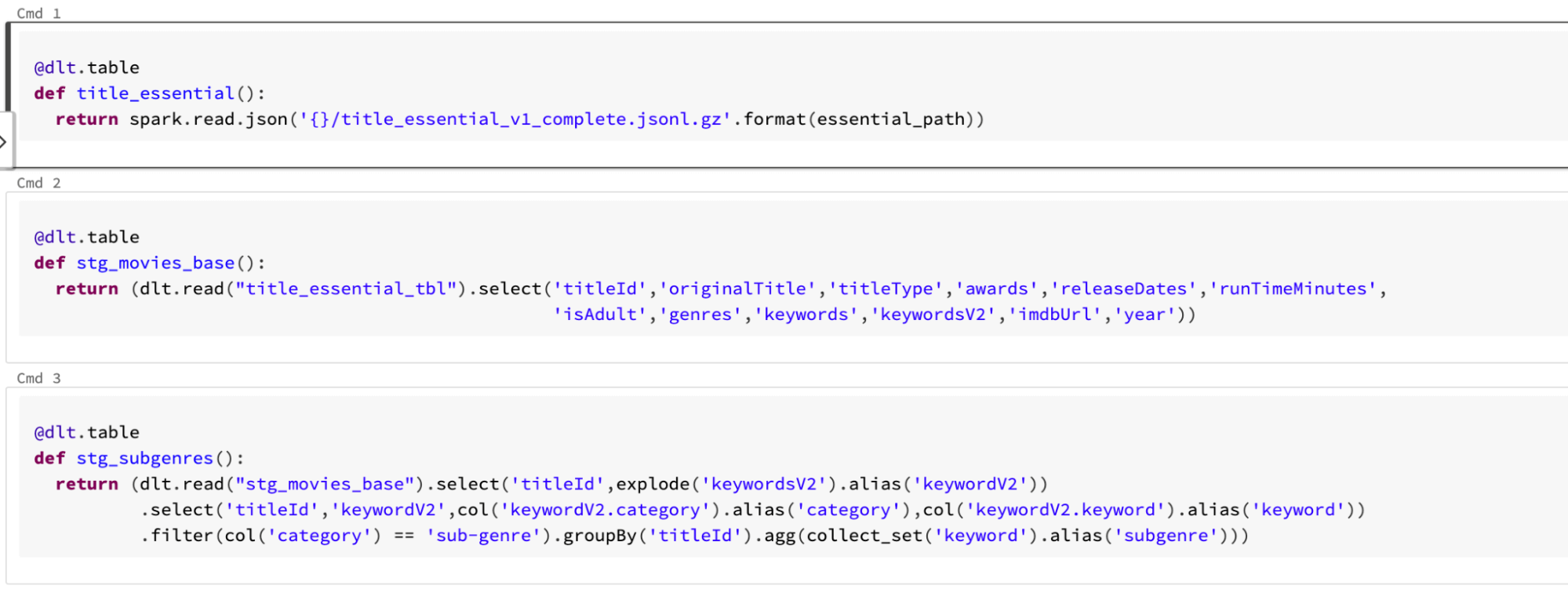Is Oscar Bait Real? We Used Databricks and IMDb Data to Find Out

In case it wasn’t clear by our 100 Years of Horror Films analysis…we really love movies here at Databricks. We’re also obsessed with data. So, with the 94th Academy Awards right around the corner, we thought it was the perfect time to once again marry these two. The topic we chose? Oscar Bait, a term used to describe films that are seemingly designed to earn an Oscar nomination.
More specifically, we wanted to know: is Oscar Bait real?
This blog post will show our approach to answering this question using Delta Live Tables (DLT) and Databricks SQL to process and analyze a rich set of data from IMDb, the world’s most popular and authoritative source for information on movies, TV shows and celebrities. In addition to uncovering some interesting findings (which we’ll share), this use case demonstrates how DLT’s declarative approach drastically reduces the work and code required to manage reliable data pipelines.
What is Oscar Bait?
At its core, Oscar Bait describes films that seem to be created with the intention of earning nominations for an Academy Award. While there is no official definition of what constitutes “Oscar Bait,” there is a generally agreed-upon list of themes and characteristics, including:
- Belong in the historical/period or tragedy subgenre
- Have long runtimes
- Released during “Oscar season,” the last few months of the year
These characteristics, while requiring some interpretation, became the foundation of the attributes we used to determine if a film was Oscar Bait and, ultimately, whether these truly correlate with Academy Award nominations or wins.
Our data & criteria
For our analysis, we used a licensed IMDb data set of Academy Award-nominated and winning films from the years 1980 to 2019. We chose this timeframe to compare films within the same modern context; for example, it isn’t analogous to compare characteristics, like runtime, of a 1929 film to a 2019 film. Note that 2020 and 2021 were outlier years for the Academy Awards given the pandemic so we cut off our analysis at 2019.
The next step was to define the attributes in our data set that constitute Oscar Bait. We identified the following:
- Film length: > 90 minute
- Release months: October, November, December
- Belongs in an Oscar Bait subgenre (see below)
- Is not an animation or documentary film
IMDb’s data set included a massive amount of subgenre labels that spanned from very broad to very specific. To narrow our scope, for our analysis, we identified relevant keywords such as period, historical, tragedy, melodrama, docudrama and epic. We selected the 20 most common subgenres that best aligned with the Oscar Bait criteria. Subgenres that included animation and fantasy were excluded since these are not considered “Oscar Bait” but can be attached to Bait subgenres, like epic.
Building our data pipelines
Last year, we announced the launch of Delta Live Tables, a framework that makes it easy to build and manage data processing pipelines.
DLT helps data engineering teams simplify ETL development and management with declarative pipeline development, automatic data testing to prevent data quality issues, and deep visibility for monitoring and recovery. This declarative approach means that data engineers simply tell DLT what they want done - and DLT takes care of the rest. Use cases can be executed with just a few lines of code.
Here’s a snippet of what the code looked like for this use case:
We then used Databrick SQL (DB SQL) to build out visualizations. DB SQL comes with tons of performance optimizations and makes it easy for analysts to build dashboards - all within a unified platform in the Lakehouse platform. You can learn more about Databricks SQL and its benefits in our previous blog.
Our analysis
We put together multiple dashboards to gain insights into Oscar trends. While our analysis focuses on surface-level trends, we did uncover some interesting insights.
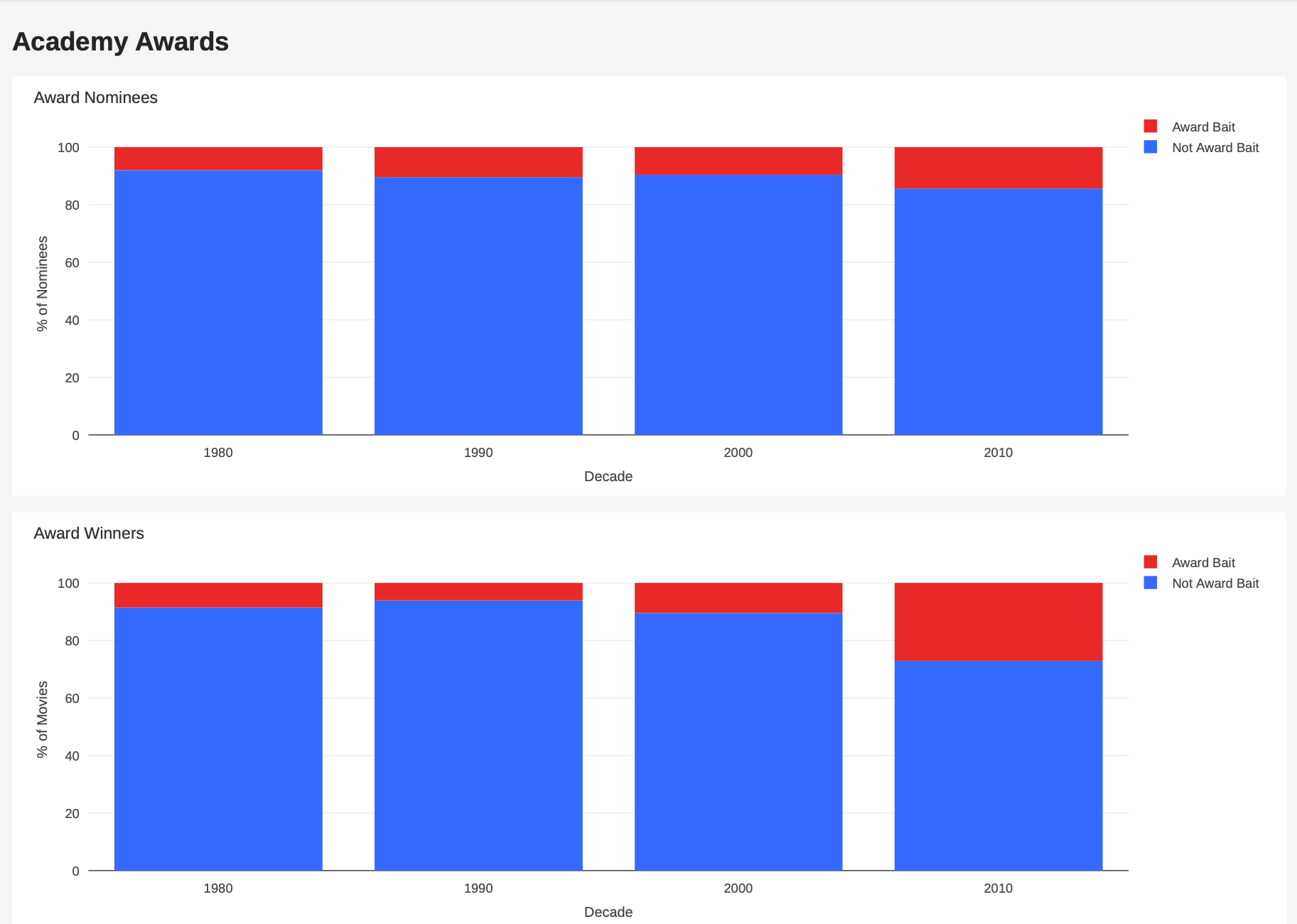
The above charts show the percentage of Academy Award nominees (top) and winners (bottom) that meet all Oscar Bait criteria. To state the obvious, Oscar Bait consistently makes up a small percentage of the films across decades. The narrative gets more interesting when we look at Academy Award wins; there’s over a 140% increase in Oscar Bait in the 2010s. But what’s driving this?
As we explain in the next few sections, what seem to be driving this are shifts in general movie trends, including longer runtimes and the increased popularity of end-of-year movie releases, docudramas and darker, more complex films.
Our hypothesis
There are certainly exceptions, but the Academy Awards generally recognize films well-received by the public. This IMDb list even shows that 100% of Best Picture-winning films have audience scores of 7.0 or higher from 1980 to 2019. But just like any other consumer product, movies go in and out of fashion.
For example, the 90s and early-2000s are considered the “golden era” of rom-coms. But studios have drastically decreased production of rom-coms, which typically don’t resonate with younger, global audiences (though there are of course exceptions). To reach today’s broad audience, the genre has been replaced by the rom-com-drama, which touches on serious topics and social commentaries, as seen in Silver Lining’s Playbook, The Artist and Her (all of which received Oscar nominations).
While it is a chicken or an egg situation, modern global audiences seem to generally prefer darker, more complex films - many of which fall into the standard “Bait” tropes.
Diving deeper
Our next analysis looked at the three attributes (runtime, subgenre and release date) individually. These analyze all Academy Award nominees to capture insights from a broader set of films.
Insight #1: Increasing runtimes
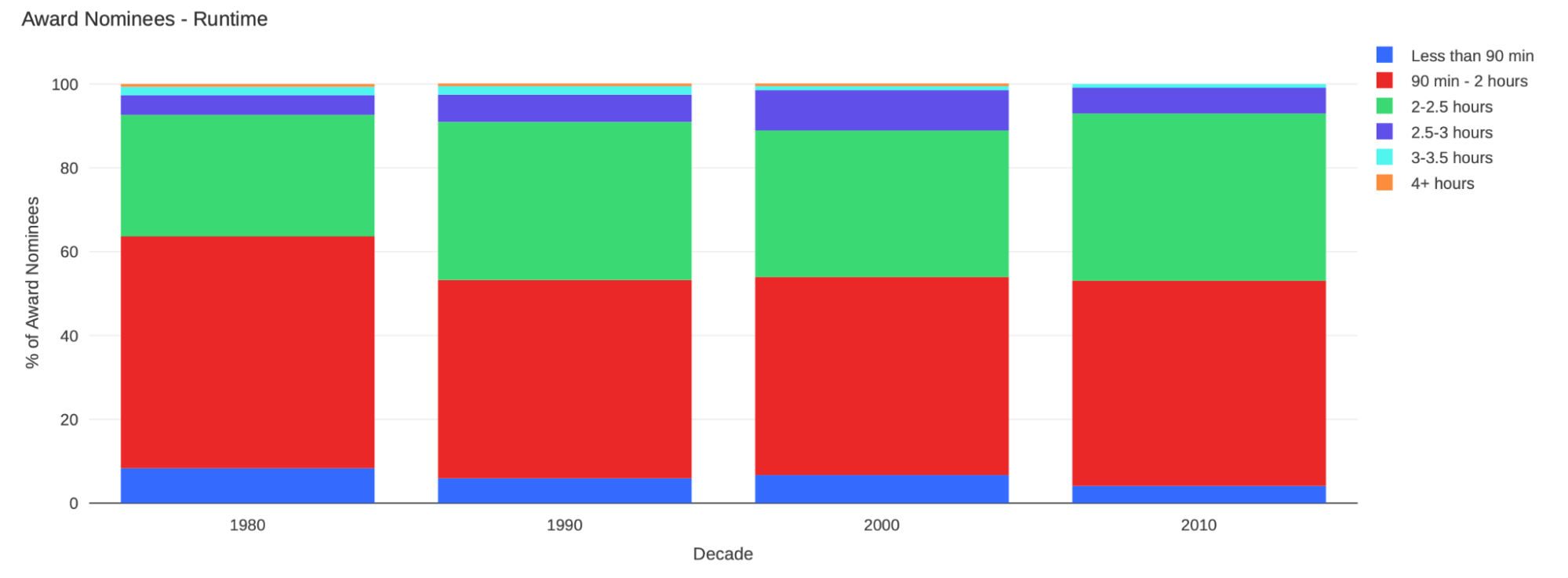
The first characteristic we looked at was runtime. As the graph shows, most films run 90 minutes to 2.5 hours across decades. However, Oscar nominees grew longer in the 1990s - with nearly a 45% increase in the 2000s among 2.5 - 3 hour films. Interestingly, Titanic, released in 1997 and clocking in at 3 hours and 14 minutes, broke modern Academy Award records and took home a groundbreaking 11 wins. It’s possible that this inspired more epic-length dramas with the hopes of emulating Titanic’s Oscar success.
The 2000s also marked the surge of epic-fantasy films (likely fueled by CGI advancements), including Avatar and the Lord of the Rings, The Hobbit and Harry Potter series. These films typically have incredibly long runtimes and many received Oscar nominations and wins.
Insight #2: Oscar season is real
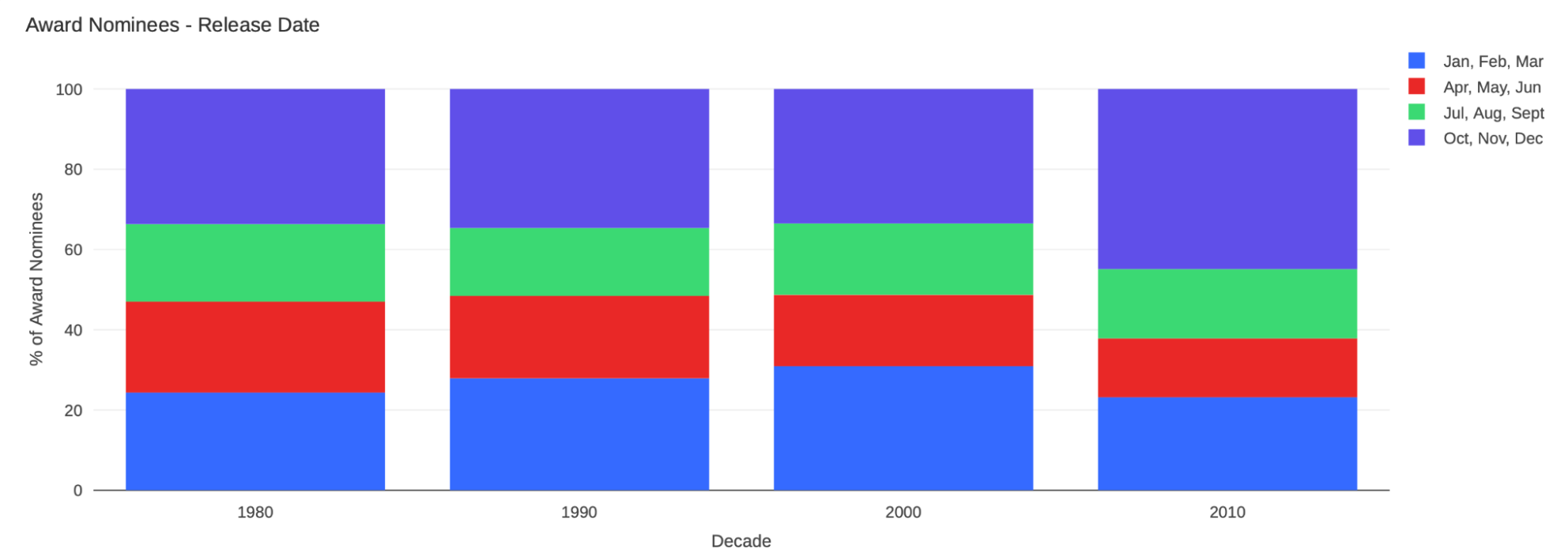
Everyone talks about “Oscar Season” - the notion that Oscar-worthy films are released at the end of the year so they’re top of mind during nomination time. The graph above shows that end-of-year has always been the most active for Oscar-nominated film releases, but grew significantly in the 2010s.
This shift also corresponds with the rise of streaming services in the mid-2000s, which brought new competition to movie theaters that were already facing declining attendance. The end of the year is also a revenue-generating machine for movie theaters due to holiday breaks, etc. – Dec 24 to Jan 1 accounted for nearly 5% of the year’s total box office receipts in 2019. With the added pressure of streaming services, it makes sense that films, in an attempt to increase revenue, would launch during the optimal moviegoing time for consumers - which also corresponds with Oscar Season.
Insight #3: The rise of the docudrama
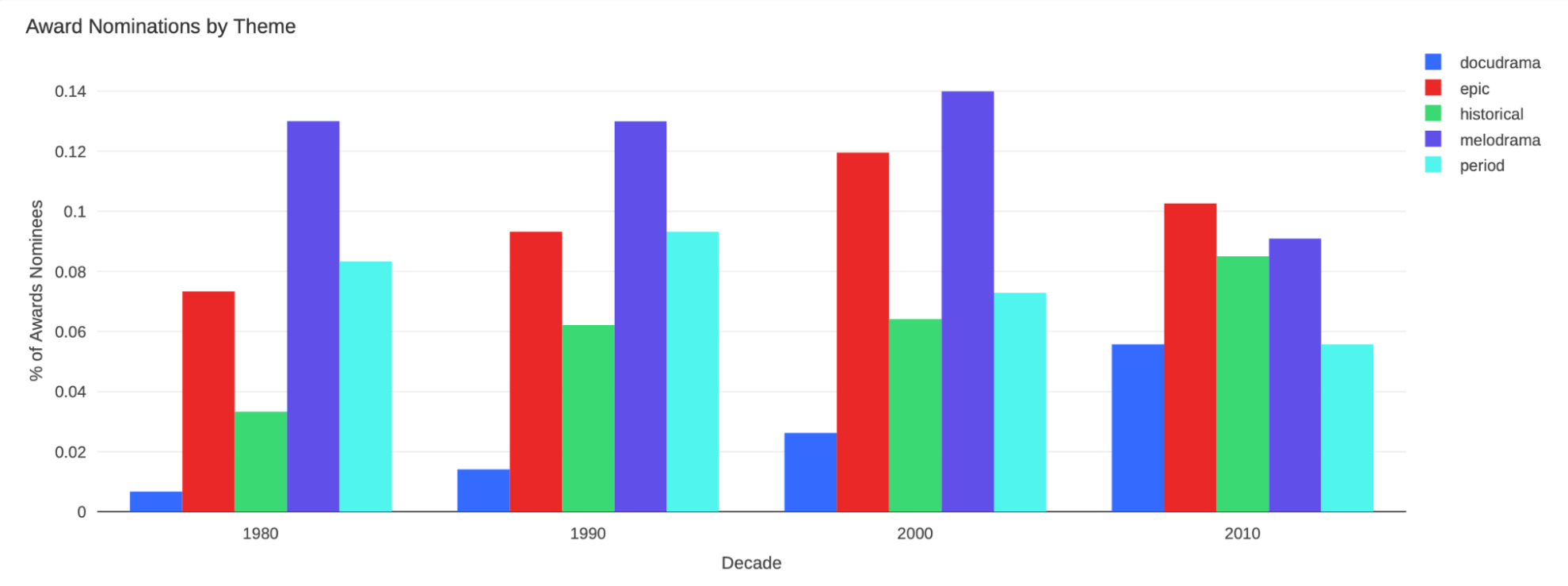
Finally, we look at shifts in subgenres. Note that the above graph only shows Academy Award-nominated films that fall within the Bait subgenres.
As you can see, in the past 10 years, there’s been a remarkable increase in films within the historical and docudrama subgenres. At the same time, period films have declined.
When looking at the Oscar nominees during the last decade, many “historical” films are less focused on the “costume or period” drama and instead highlight historical moments that are more directly relevant to modern audiences. We see this first with The Social Network (2010), which came out when social media was becoming an integral part of our lives; Imitation Game, while covering an older topic, speaks to the current rise of technology. Academy Award winners such as Wolf of Wallstreet and The Big Short speak to the recent economic recession and discussions on wealth in the US.
This decade also marks when CGI became more advanced, paving the way for opportunities to more realistically or intricately cover historical topics. For example, films such as The Irishman (which used de-aging techniques), 1917 and First Man fit within an “Oscar Bait” subgenre and were all nominated for Academy Awards for their special effects.
Conclusion
So, is Oscar Bait real?
While our research does not factor in patterns such as marketing influences and representation among Academy members who determine the nominated and winning films, it does suggest that many films recognized by the Academy fall outside of “Oscar Bait” tropes. In many cases, labeling specific films as such is overly simplistic and ignores broader film trends. We’re curious to see if the 94th Academy Awards evolves this narrative.
Interested in trying a similar analysis yourself? Learn more about Delta Live Tables by requesting a Private Preview.
More about IMDb
With hundreds of millions of searchable data items — including 8 million movie, TV and entertainment titles, 11 million cast and crew members and 12 million images — IMDb is the world’s most popular and authoritative source for information on movies, TV shows and celebrities, and has a combined web and mobile audience of more than 200 million monthly visitors.
IMDb enhances the entertainment experience by empowering fans and professionals around the world with cast and crew listings for every movie, TV series and video game, lifetime box office grosses from Box Office Mojo, proprietary film and TV user ratings from IMDb's global audience of over 200 million fans, and much more.
IMDb licenses information from its vast and authoritative database to third-party businesses, including film studios, television networks, streaming services and cable companies, as well as airlines, electronics manufacturers, non-profit organizations and software developers. Learn more at developer.imdb.com.
Never miss a Databricks post
What's next?

News
December 11, 2024/4 min read
